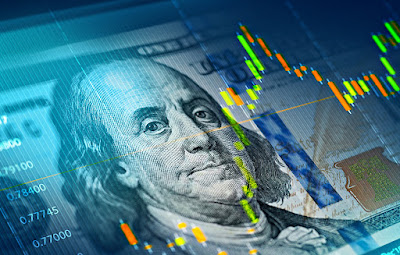The new covid variant injected a new dynamic into the foreign exchange market. The World Health Organization cautioned against the need to impose travel restrictions, but policymakers, by and large, do not want to be bitten by the same dog twice. To err on the side of caution is to minimize one's biggest regret. The risk is that the uncertainty is not lifted quickly but lingers, which would likely unpin volatility. US and European benchmark 10-year yields fell sharply ahead of the weekend. In the US, the market unwound some of its aggressive pricing in of Fed policy. This is reflected in the commensurate drop at the short-end. In Europe, the decline in 10-year yield reflected a slowing of growth/inflation as its short-end was largely unchanged. There are
Topics:
Marc Chandler considers the following as important: 4.) Marc to Market, 4) FX Trends, Featured, newsletter, USD
This could be interesting, too:
Nachrichten Ticker - www.finanzen.ch writes Die Performance der Kryptowährungen in KW 9: Das hat sich bei Bitcoin, Ether & Co. getan
Nachrichten Ticker - www.finanzen.ch writes Wer verbirgt sich hinter der Ethereum-Technologie?
Martin Hartmann writes Eine Analyse nach den Lehren von Milton Friedman
Marc Chandler writes March 2025 Monthly
The new covid variant injected a new dynamic into the foreign exchange market. The World Health Organization cautioned against the need to impose travel restrictions, but policymakers, by and large, do not want to be bitten by the same dog twice. To err on the side of caution is to minimize one's biggest regret. The risk is that the uncertainty is not lifted quickly but lingers, which would likely unpin volatility.
US and European benchmark 10-year yields fell sharply ahead of the weekend. In the US, the market unwound some of its aggressive pricing in of Fed policy. This is reflected in the commensurate drop at the short-end. In Europe, the decline in 10-year yield reflected a slowing of growth/inflation as its short-end was largely unchanged.
There are three areas in which market participants cannot be as confident as they were in the middle of last week. First, the odds of a Bank of England hike next month were diminishing and fell further at the end of last week. Second, an acceleration in the Fed's tapering seemed increasingly likely given the strength of recent data and the jump in price pressures. However, the emergence of this new strain makes an aggressive rate hiking campaign less likely. Third, the prospects for stronger world growth diminished on the margins. This undermines risk appetites and weakens those currencies that often appear to do better in robust growth phases (e.g., dollar bloc, Scandis, and most emerging market currencies).
Dollar Index: The Dollar Index put in a new high for the year on November 24, slightly below 97.00. It was confined to a narrow range when the US markets were closed on November 25 and sold off on news of the new variant and imposition of travel controls by several countries. The setback was sufficient to turn the MACD lower from over-extended territory, though the Slow Stochastic hasn't and remains stretched. If we assume a correction has begun, a key question is what move is being retraced. A conservative but logical assumption is that the last leg up, since the November 10 CPI, is in play. The first (38.2%) target is near 95.75, and then the (50%) retracement is around 95.40. A break of 95.00 could signal another cent decline.
Euro: Interest rate differentials and the surge in delta variant cases had sent the euro to almost $1.1185 in the middle of the last week, the lowest since July 2020. When news of the new variant broke, what appears to be a short-covering rally lifted the euro to almost $1.1325. The (38.2%) retracement of the leg down since November 10 is near $1.1340. A more formidable resistance area is in the $1.1375-$1.1400 band. As was the case with the Dollar Index, the MACD is turning, but the Slow Stochastic is lagging. Initial support now is seen near $1.1260. With the old and now new variant, the surge accelerated inflation expected to be reported next week may not be the fodder for the ECB has that some anticipated.
Japanese Yen: We have suggested that the dollar was in a JPY113-JPY115 range. Earlier this month, it had dipped briefly below JPY112.75 and snapped back. Indeed, in the first part of last week, it was fraying the upper end of the range and traded slightly through JPY115.50. However, the pre-weekend turmoil saw the greenback drop back to the lower end of the range (~JPY113.05). The trendline connecting the August low and the two November lows, found near JPY114.10 ahead of the weekend, was taken out with determination. The MACD is turning down but never recovered from the mid-October-mid-November decline. The Slow Stochastic is edging back into over-extended territory.
British Pound: As the December short-sterling futures contract rallied, implying a less likely chance of a BOE hike before year-end, the pound fell. The interest rate futures contract will begin next week with a seven-day rally intact. Sterling, itself has fallen for six sessions, and a new low for the year was set near $1.3320 before the weekend. Here, both the MACD and Slow Stochastic are falling while being over-extended on the downside. A move above $1.3350 would help stabilize the tone, but it requires a push above $1.3400 to be notable. On the downside, we continue to see a risk of a test on the $1.3165, the first retracement (31.8%) of sterling's rally since Mach 2020.
Canadian Dollar: Talk about trending currencies; the Canadian dollar fell for the fifth consecutive week following a five-week rally. Net-net, it is little changed. The US dollar settled near CAD1.2765 on September 17, which was between the Bank of Canada meeting and the FOMC. The greenback reached CAD1.28 ahead of the weekend before settling back near CAD1.2760. There is little chart resistance until closer to CAD1.29. As one would expect, the momentum indicators are stretched and frayed the upper Bollinger Band (~CAD1.2770). It requires a break of the CAD1.2630-CAD1.2640 area to be meaningful.
Australian Dollar: In the pre-weekend carnage, the Australian dollar came within a whisker of the year's low set in August near $0.7100. The Aussie, like the Canadian dollar, has been streaking. Its four-week decline comes are a four-week rally. The move was underway before the new variant was announced. The next target is around $0.7050, the (38.2%) retracement of the rally from the March 2020 low (~$0.5500). Below there is the $0.7000 area, which caught the lows in September and October 2020. The MACD continues to fall, while the Slow Stochastic has begun to flatline in the trough. The 25 bp hike by the Reserve Bank of New Zealand, which was fully expected, and disappointed those that looked for a larger move, did little to support the New Zealand dollar. Indeed, it was the worst-performing major currency last week, losing about 2.5%, more than twice as much as the Canadian dollar and two-thirds more than the Australian dollar. It also tested the year's low set in August (~0.6800). A break would open the door to steeper losses, but the next area of support may be found in the $0.6760-$0.6780 area.
Mexican Peso: The peso was the second weakest currency in the world last week (after the Turkish lira), falling around 4.3% to a new low for the year. It had three strikes against it last week. First, emerging market currencies broadly are out of favor. The JP Morgan Emerging Market Currency Index has fallen for 10 of the past 12 weeks. Second, the new variant and the dramatic risk-off saw the peso's losses accelerate. Third are domestic considerations. AMLO's nomination to head the central bank starting next year did not bolster the market's confidence, which was on the heels of the Turkish debacle. Also, domestic economic conditions have worsened. The data have been softer than expected, including a downward revision in Q3 GDP showing a contraction of 0.4% rather than 0.2%. At the same time, the bi-weekly CPI rose above 7%. Ahead of the weekend, the dollar rose to MXN22.1550, and although it pulled back, it found support above the previous session's high (~MXN21.60). Nearly all the emerging market currencies fell against the dollar (The Brazilian real was a notable exception. It eked out ~0.5% gain). However, Mexico seems particularly vulnerable. The credibility of the central bank may be called into question. The economic challenge of surging inflation and weak economic activity would seem to require fiscal support, for which AMLO shows little interest. In April 2020, the greenback reached nearly MXN25.7850, and the MXN22.47 area corresponds to the halfway mark of its subsequent decline.
Chinese Yuan: Chinese officials appear to have expressed mild displeasure with the foreign exchange market, cautioning against a one-way market and checking prop positions. Officials would seem to think that the banks are short dollars, while many outside observers, trying to reconcile the large current account surplus with little currency movement and stable reserves, think the large banks are accumulating dollars ostensibly on behalf of officials (hence the talk of stealth intervention). In fact, the one-way market has been broken. On November 16, the dollar traded between CNY.3670 and CNY6.3965 and has not moved out of that range. We suspect the risk is for an upside break for the dollar and initially see a move toward CNY6.42.
Tags: #USD,Featured,newsletter









